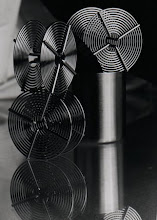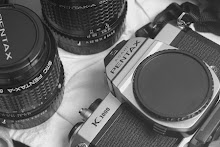Camera reviews don't tell us everything. They can be written by sitting down with a sales brochure, or they can be a summary of some pretty sophisticated testing. The main ingredient that's missing is our own experience. For beginners, the reviews can be a mystery of fantasies.
If you are a beginner out there, looking over reviews to buy your first "real" camera, or stepping up to a new DSLR, I recommend you write your own little review before buying that new camera.
Write a review of a real piece of junk.
I mean, garbage or near garbage. Review a camera yourself that's been fished out of the trash. Borrow one from that distant cousin who gave it to his toddler to chew on. Pull it out from between the cushions of the bench seat of a minivan with parched paint; wipe the snack crumbs off of the scratched plastic exterior, and use that camera for a week.
Corroded batteries? Replaced with whatever AAs you scavenged from something else.
Operating system? Windows 95 compatible, at best. Anything "barely usable" with your favorite computer is a plus.
If you are looking to buy a DSLR, fish out that really bad, but digital, point and shoot camera. It should look so bad that everyone else in the world believes it is useless, inoperable plastic junk.
Then use it, with vigor, for a week. Establish your sense of new lows. Recognize what's still good about the camera. Note those inconveniences you experience as you try to get the thing working.
Pay no more than $25 for this little experiment, all in. Borrowed equipment might work best.
Then, head on over to your favorite source of camera reviews. Often, there will be a summary of criteria used to judge the camera. Build one of those same lists for your piece of junk under testing.
Then re-read those camera reviews that interested you before you started your own testing. You might notice a few things:
The stuff you noticed about your junk camera might not be on the summary list in a way that fits into a neat category. Isn't it important for you to avoid those problems? This can help you identify sins of omission in reviews.
The good stuff about the camera might not be listed in the newer reviews. Why not? Superior technology? Or, was part of the good stuff not in the camera, but in the photographer?
If your junk camera did not fit your specifications for your preferred uses, why not? Was there a part that didn't comply with your needs? How so? This can help you identify which specifics are important to you in a camera.
Were there acronyms of specific tests which showed off one feature that's in your desired camera that are somehow not in other cameras? Why is that? Was the equipment special in its design, or is that acronym a marketing ploy?
Then, consider reviewing the camera you normally use, if you have another one. Run through this the same way. See how it stacks up. Do you really need a new camera?
If you want to make photos of wildlife, and all you have is a point and shoot, at least by now you should begin to specify what field of view you would like to have against what format size.
All in, this simple exercise can help you gain some experience with the equipment, and keep you from getting suckered as quickly by marketing schemes.







No comments:
Post a Comment